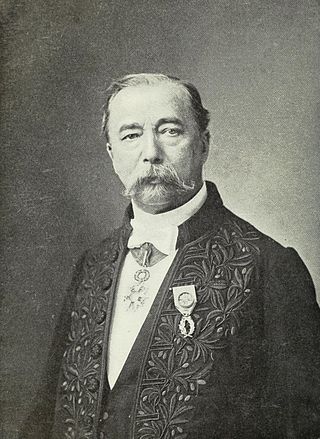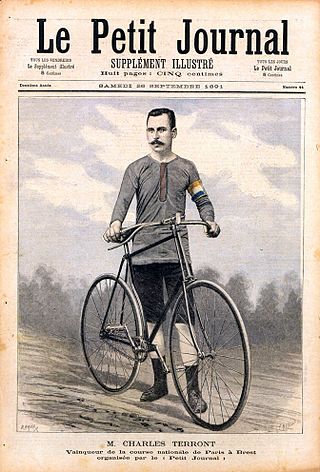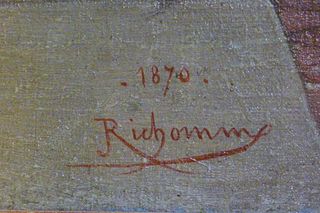Related Research Articles

A ball bearing is a type of rolling-element bearing that uses balls to maintain the separation between the bearing races.

A bearing is a machine element that constrains relative motion to only the desired motion and reduces friction between moving parts. The design of the bearing may, for example, provide for free linear movement of the moving part or for free rotation around a fixed axis; or, it may prevent a motion by controlling the vectors of normal forces that bear on the moving parts. Most bearings facilitate the desired motion by minimizing friction. Bearings are classified broadly according to the type of operation, the motions allowed, or the directions of the loads (forces) applied to the parts.

Pierre Athanase Larousse was a French grammarian, lexicographer and encyclopaedist. He published many of the outstanding educational and reference works of 19th-century France, including the 15-volume Grand dictionnaire universel du XIXe siècle.

Jules Alfred Huot de Goncourt was a French writer, who published books together with his brother Edmond. Jules was born and died in Paris. His death at the age of 39 was at Auteuil of a stroke brought on by syphilis.

James Moore was an English bicycle racer. He is popularly regarded as the winner of the first official cycle race in the world in 1868 at St-Cloud, Paris, although this claim seems to be erroneous. In 1869 he won the world's first road race Paris–Rouen sponsored by Le Vélocipède Illustré and the Olivier brothers' Michaux Bicycle Company. Moore covered the 113 km (70 mi) in 10 hours and 25 minutes. He was one of the first stars of cycle racing, dominating competition for many years.

Jules Joseph Lefebvre was a French painter, educator and theorist.

A velocipede is a human-powered land vehicle with one or more wheels. The most common type of velocipede today is the bicycle.

Vehicles that have two wheels and require balancing by the rider date back to the early 19th century. The first means of transport making use of two wheels arranged consecutively, and thus the archetype of the bicycle, was the German draisine dating back to 1817. The term bicycle was coined in France in the 1860s, and the descriptive title "penny farthing", used to describe an "ordinary bicycle", is a 19th-century term.
Didot is the name of a family of French printers, punch-cutters and publishers. Through its achievements and advancements in printing, publishing and typography, the family has lent its name to typographic measurements developed by François-Ambroise Didot and the Didot typeface developed by Firmin Didot. The Didot company of France was ultimately incorporated into the modern CPI printing group.

The French bicycle industry and the history of the bicycle are intertwined. Spanning the last century and a half, the industry has seen two booms, and continues into the 21st century, albeit less dominant today.
Charles-Saint-Ange Thilorier was a student at the École polytechnique in the class / year of 1815, who was mistakenly believed to have been the first person to create solid carbon dioxide. Actually, a French inventor, Adrien-Jean-Pierre Thilorier (1790–1844), discovered dry ice.
The Garrard & Blumfield or Blumfield & Garrard was an English electric car manufacturer from 1894 to 1896. The company is presumed to have been founded by C. R. Garrard and T. W. Blumfield.

Ernest Saint-Charles Cosson was a French botanist born in Paris.
Events from the year 1868 in France.

Jules René Bourguignat was a French malacologist, a scientist who studied mollusks. He served as secretary-general of the Société malacologique de France. He traveled widely, visiting, for example, Lake Tanganyika and North Africa. He reportedly defined 112 new genera and around 2540 new species of mollusks.

Le Vélocipède Illustré was a fortnightly illustrated French newspaper which covered cycling, water sports, mechanical arts and sciences, fine arts, and industry. First published in Paris on the 1 April 1869 by Richard Lesclide, it continued publication until 1872.

Charles Terront was the first major French cycling star. He won sprint, middle distance and endurance events in Europe and the United States. In September 1891 he won the first Paris–Brest–Paris cycle race, which at 1,196 kilometres (743 mi) was more than double the length of any previous event. He rode a Humber bicycle fitted with prototype removable pneumatic tyres made by Michelin. He won 54 major events over his 15-year career, was Champion of France twice and Champion of Great Britain twice.

Jules Richomme was a French portrait, landscape, genre and history painter.
Antoine Gadon better known as Dunan Mousseux was a 19th-century French journalist, chansonnier and playwright.
References
- 1 2 Mozer, D. "Bicycle History (& Human Powered Vehicle History)". iBike. Retrieved 2010-04-23.
- ↑ See:
- Suriray, "Perfectionnements dans les vélocipèdes" (Improvements in bicycles), French patent no. 86,680, issued: August 2, 1869, Bulletin des lois de la République française (1873), series 12, vol. 6, page 647.
- Louis Baudry de Saunier, Histoire générale de la vélocipédie [General history of cycling] (Paris, France: Paul Ollendorff, 1891), pages 62-63. De Saunier points out that ball bearings had been patented both in France in 1857 by Mssrs. Courtois, Tihay and Defrance, and in the United States in 1861 (patent no. 32,604; issued: 18 June 1861).
- ↑ Jules Pierre Suviray. On trouve sa statue dans la cours du musée des Arts et Métiers à Paris.